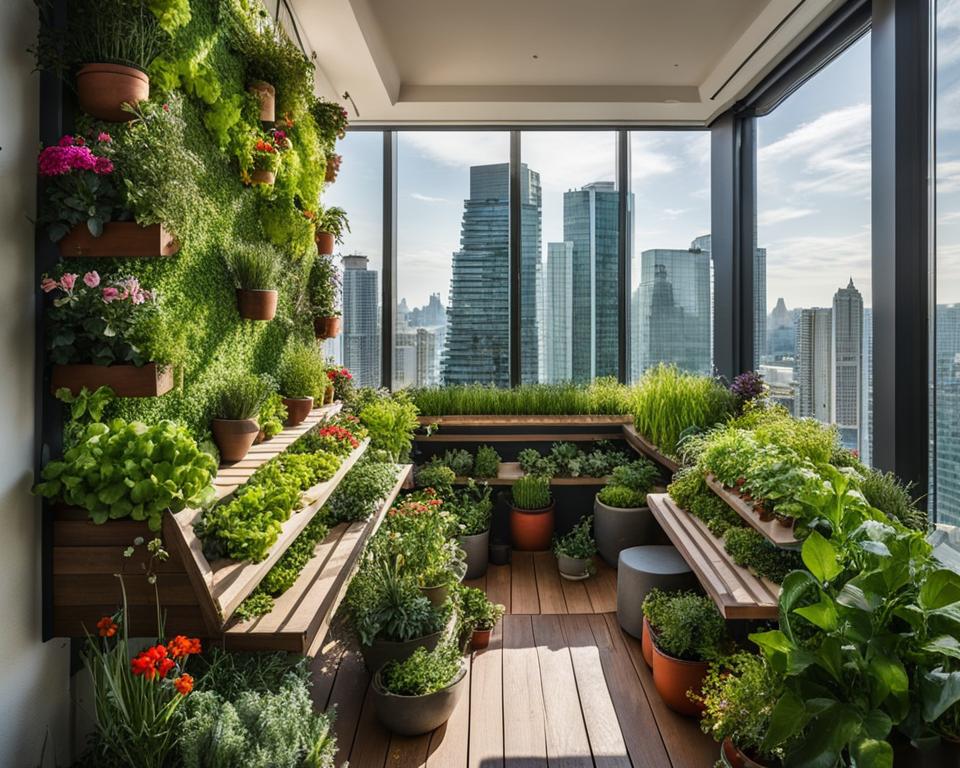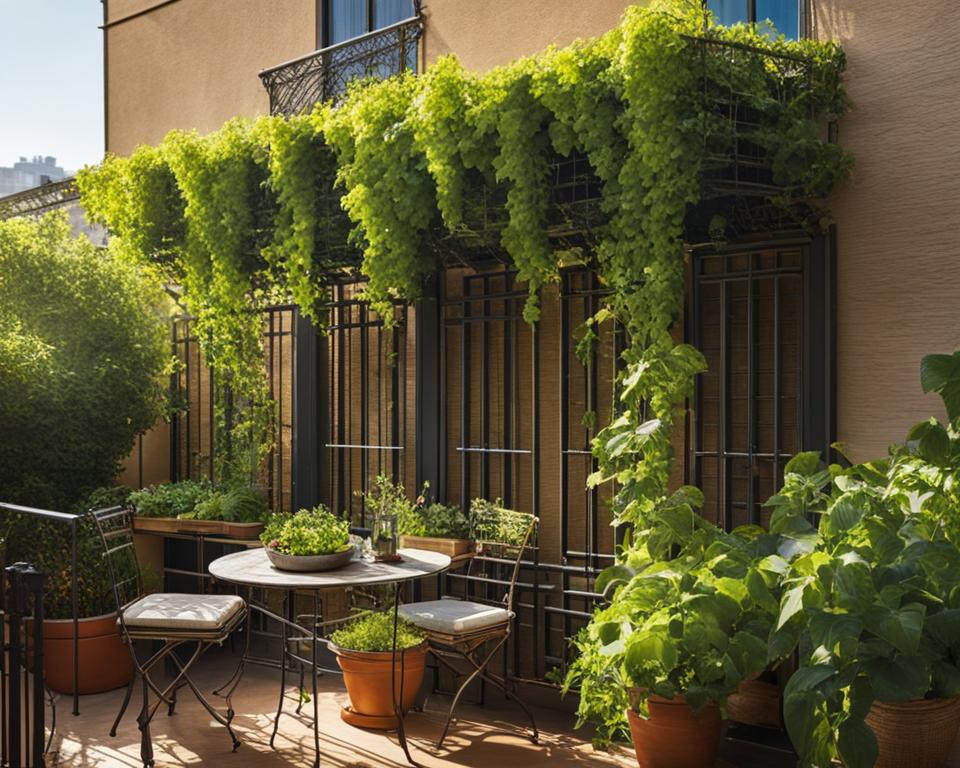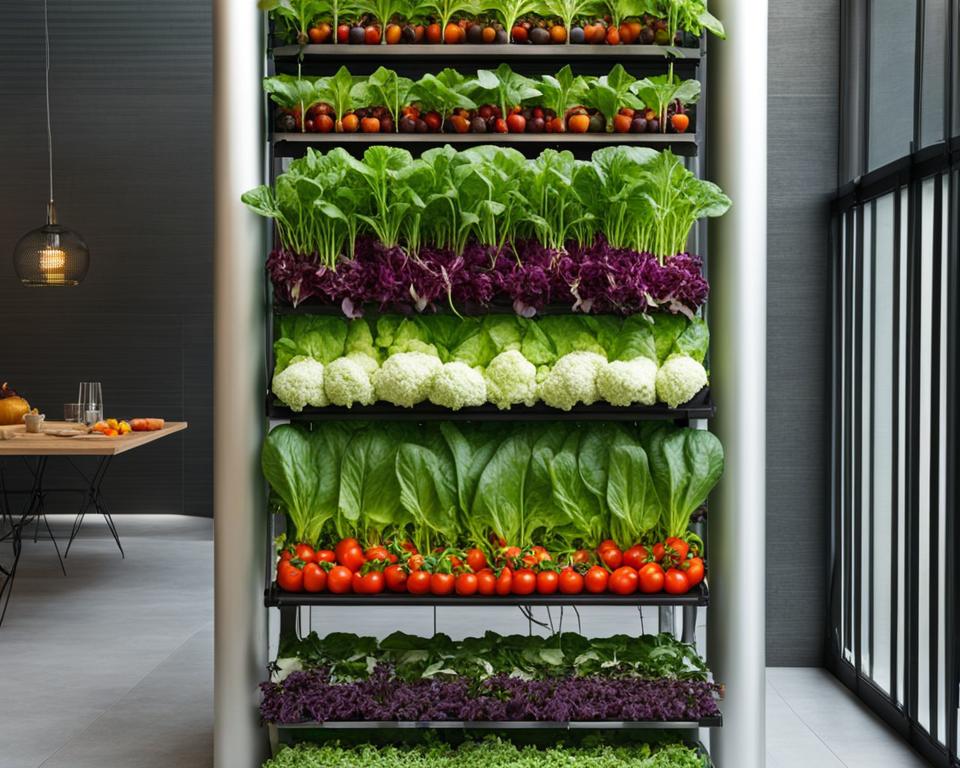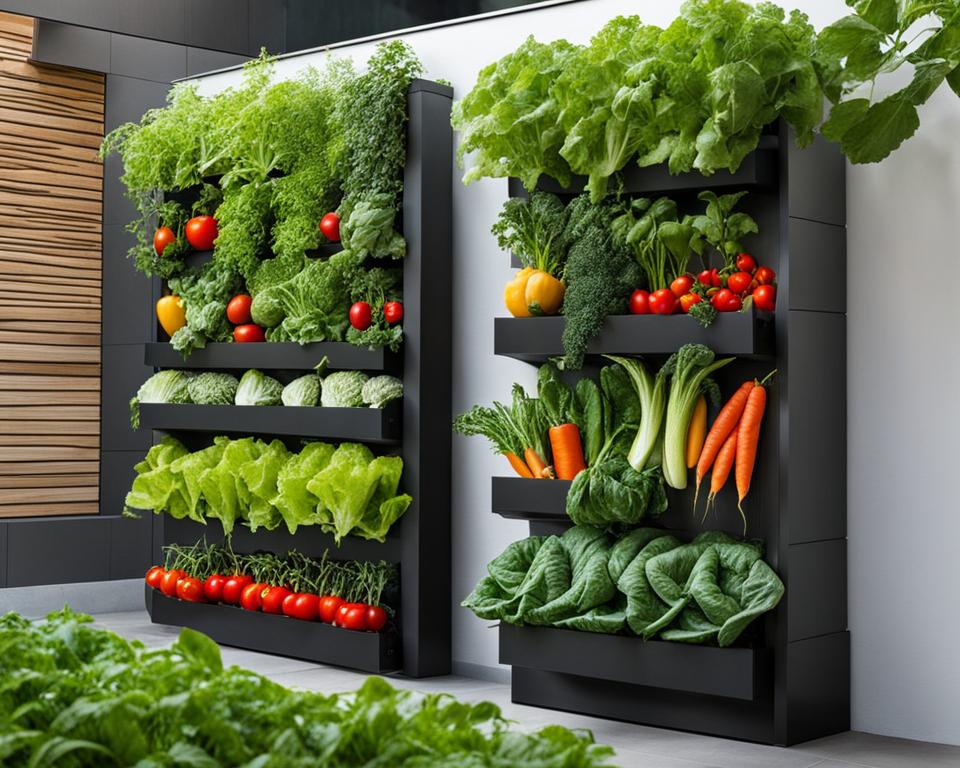As an urban gardener, limited space can be a major challenge. However, with vertical vegetable gardening, you can create a thriving garden even in a small apartment balcony or a tiny backyard. Vertical gardening involves growing plants upwards instead of horizontally, making it a perfect fit for urban spaces. In this section, we will explore the top vertical vegetable gardening ideas specifically designed for urban spaces. Discover creative ways to grow vegetables vertically and maximize your limited space with innovative garden designs.
Key Takeaways:
- Vertical vegetable gardening is a great way to maximize your limited urban space and grow fresh produce.
- Vertical gardening involves growing plants upwards instead of horizontally.
- There are various vertical gardening options, such as vertical wall gardens, hanging baskets, and trellises.
- Choosing the right plants, containers, and tools is crucial for successful vertical vegetable gardening.
- DIY vertical gardening projects are a fun and budget-friendly way to create your own vertical garden.
Choose the Right Plants for Vertical Gardening
Vertical gardening is a fantastic way to make the most of limited spaces while enjoying fresh produce. However, not all vegetables are suitable for growing vertically. Some plants require more support or space to grow properly, while others can thrive in compact conditions. Here are some tips for choosing the right plants for your vertical garden:
- Consider the mature size of the plant: Choose vegetables that don’t grow too tall or wide, such as cherry tomatoes, lettuce, and herbs.
- Look for climbing or vining vegetables: Plants that naturally grow tall or have tendrils can be trained to grow vertically, such as beans, peas, cucumbers, and squash.
- Avoid heavy or oversized fruits: Vegetables like pumpkins, watermelons, and eggplants may be too heavy or too big for a vertical garden.
- Choose crops that have a high yield: You want to maximize your space, so pick vegetables that produce a large quantity of food, like peppers and tomatoes.
By selecting vegetables that adapt well to vertical growing, you can ensure that your garden thrives and provides a bountiful harvest. Don’t be afraid to experiment with different crops and techniques until you find the combination that works best for you.
Vertical Gardening Tips: Growing Vegetables Vertically
Growing vegetables vertically requires a bit of planning and preparation to ensure success. Here are some tips to help your plants thrive:
- Provide adequate support: Make sure your vertical garden structure can support the weight of the plants and provide the necessary anchoring. Use trellises, stakes, or cages, depending on the vegetable.
- Choose the right soil: Use good quality potting soil that has enough nutrients to support the growth of your plants. Consider adding compost or fertilizer to enrich the soil and promote healthy growth.
- Water regularly: Because vertical gardens tend to have less soil volume, they can dry out quickly. Water your plants regularly, ensuring that the soil stays moist but not waterlogged.
- Prune regularly: Remove dead or diseased foliage and prune back vigorous growth to prevent overcrowding and promote airflow. This can help prevent pests and diseases.
- Harvest frequently: Regular harvesting encourages more growth and prevents your vegetables from becoming overripe or inedible. Plus, it ensures that you get to enjoy your hard work regularly!
With these tips, you’re ready to start growing your own vertical vegetable garden. Remember to choose the right plants for your space and provide the necessary care to ensure a successful harvest. Happy gardening!
Vertical Vegetable Wall Gardens
Vertical vegetable wall gardens are not only practical but also a creative addition to your urban garden. They can transform a plain wall into a stunning living tapestry of colors and shapes. Here are some vertical gardening tips to help you create your own vegetable wall garden:
Design and Materials
The design of your vertical vegetable garden depends on your preference and available space. Some popular designs include using wooden pallets, old gutters, or hanging canvas planters. You can also create a custom design by combining different materials and adding decorative elements.
When selecting materials, make sure they are sturdy enough to hold the weight of the soil and plants. Also, consider the amount of sunlight and water your plants will need and choose materials that won’t deteriorate quickly.
| Materials | Pros | Cons |
|---|---|---|
| Wooden pallets | Easy to find, customizable, can be layered for more space | May require reinforcement, not suitable for wet environments |
| Hanging canvas planters | Portable, lightweight, easy to install | May dry out quickly, limited space |
| Old gutters | Durable, narrow profile, space-saving | May rust, require drilling to install |
Choose a design and materials that complement your existing garden or add a pop of color to your wall with fresh greens and vegetables.
Plant Selection
When selecting plants for your vertical wall garden, consider their growth habits, sunlight requirements, and water needs. Some vegetables that are suitable for vertical gardening include:
- Tomatoes
- Cucumbers
- Peppers
- Lettuce
- Radishes
- Green beans
To achieve a vibrant and diverse garden, consider planting a mix of vegetables, herbs, and flowers. Herbs such as basil, parsley, and thyme can add fragrance and flavor to your dishes, while flowers such as marigolds and pansies can attract pollinators and deter pests.
Maintenance
Vertical vegetable wall gardens require proper maintenance to thrive. Here are some tips to keep your garden healthy:
- Water your plants regularly, making sure the soil is evenly moist but not waterlogged.
- Fertilize your plants periodically to provide essential nutrients for growth.
- Prune your plants to control their size and shape and promote healthy growth.
- Monitor your garden for pests and diseases and take appropriate measures to prevent or treat them.
A well-maintained vertical wall garden can provide fresh produce and a beautiful backdrop for your urban space. Get creative with your design and plant selection, and enjoy the rewards of your hard work.
Tiered Vertical Planters
If you’re dealing with limited space, tiered vertical planters can be a great option for maximizing your yield. They’re versatile, making them great for small space vegetable gardening, and they come in various designs for every type of garden.
Shelves
One unique way to utilize tiered planters is with shelves. You can find shelves that are designed specifically for plants, or you can build them yourself. Using a ladder shelf is a great way to save floor space while adding a pop of style to your space.

| Pros | Cons |
|---|---|
| Easy to maintain | Requires frequent watering |
| Easy access to all plants | Can get crowded if not spaced properly |
| Great for herbs and small plants | May not be suitable for larger plants |
Stacked Planters
Another popular option for tiered vertical planters is stacked planters. These are usually made up of a series of pots that stack on top of each other to create a tower of plants. They come in various sizes, from small countertops to large outdoor towers.
“Stacked planters are a great option if you’re looking to add some height and dimension to your garden.”
- Choose plants that have similar needs for soil and sun
- Be mindful of weight and stability when stacking
- Consider adding a drip irrigation system for easy watering
Plant Arrangement
When arranging your plants in tiered planters, it’s important to consider their growth patterns. Place taller plants on the bottom and shorter plants on the top to ensure everyone gets enough sunlight. And, keep plants with similar watering needs together to make it easier to keep them hydrated.
With these tips and ideas, you can create a thriving tiered vertical planter garden in even the smallest of spaces. Happy planting!
Hanging Baskets and Pots for Small Space Vegetable Gardening
If you have limited space but still want to grow vegetables, consider using hanging baskets and pots. These versatile options are perfect for vertical gardening and can add a beautiful touch to your urban garden.
When selecting containers for your hanging garden, choose materials that are lightweight and sturdy. Plastic, resin, and metal are great options. Make sure the container has drainage holes to prevent water from accumulating.
For small space vegetable gardening, choose vegetables that don’t require a lot of space to grow. Some great options include cherry tomatoes, peppers, lettuce, and herbs.
When arranging your plants, consider the amount of sunlight they need and how much space they require to grow. Hanging baskets and pots can be placed on walls, balconies, or even hung from the ceiling to maximize your space.
Tips for Growing Vegetables in Hanging Baskets and Pots
- Use a high-quality potting soil mix with added compost for nutrients.
- Water your plants regularly, making sure not to overwater or underwater them.
- Fertilize your vegetables every two weeks with a balanced fertilizer.
- Rotate your hanging baskets and pots regularly to ensure even growth and sun exposure.
- Keep an eye out for pests and diseases and take action immediately if you notice any issues.
With these tips and the right selection of vegetables, you can create a stunning hanging garden that will provide you with fresh produce all season long.

Building an Arbor
Arbors are a bit more complicated to build but can be worth the effort for their beauty and functionality. Start by constructing a sturdy frame using wooden posts and beams. Then, add lattice panels to the sides and top of the arbor. You can also add benches or chairs for a relaxing outdoor space.
Cultivating Vining Plants
As your vining plants grow, guide them up the trellis or over the arbor to help them climb. Regularly prune your plants to prevent overgrowth and ensure they are getting enough sunlight. As your plants produce fruits or vegetables, use netting or bags to support their weight and prevent damage to the structure.
Trellises and arbors are not only practical solutions for vertical gardening but also add charm to your outdoor space. Follow these vertical gardening tips and techniques to create a beautiful and functional garden.
Vertical Hydroponic Systems
If you’re looking for a space-saving and efficient way to grow vegetables, vertical hydroponic systems might be just what you need. These systems allow you to grow plants without soil, using only water and nutrients. Here are some tips for successful vertical hydroponic gardening:
- Choose the right system for your space: There are various types of hydroponic systems, such as drip systems, nutrient film technique, and deep water culture. Make sure to choose a system that fits your available space and matches your growing goals.
- Start with easy-to-grow plants: If you’re new to hydroponic gardening, it’s best to start with vegetables that are easy to grow, such as lettuce, herbs, and cherry tomatoes.
- Provide adequate light: Light is crucial for plant growth, and in hydroponic systems, you’ll need to provide artificial light sources, such as LED or fluorescent lights. Make sure to adjust the light intensity and duration according to your plants’ needs.
- Monitor water and nutrient levels: Hydroponic plants rely on a constant supply of water and nutrients, so it’s essential to monitor and adjust these levels regularly. Use a pH meter and nutrient solution tester to ensure optimal growing conditions.
Overall, vertical hydroponic systems are a great option for small space vegetable gardening and offer a unique and innovative way to grow fresh produce in urban areas.

DIY Vertical Garden Projects
If you’re looking for a fun and creative way to start your own vertical vegetable garden, look no further than these DIY projects. DIY vertical gardening allows you to create a custom garden that fits your space, style, and budget.
There are countless ideas out there for DIY vertical garden projects, but here are a few to get you started:
1. Pallet Planter
A pallet planter is an easy, affordable way to create a vertical garden. Simply add soil and plants to the pockets between the slats, and hang it up on your wall or fence. Not only is it practical, but it adds a rustic charm to any space.
2. Hanging Gutter Garden
A hanging gutter garden is a great way to reuse old gutters and turn them into a functional piece of art. Cut the gutters into equal sections, drill holes for drainage, add soil and plants, and hang them up. You can use one section or several to create an eye-catching vertical garden.
3. Shoe Organizer Herb Garden
Repurpose a hanging shoe organizer into an herb garden. Simply fill the pockets with soil, add herbs, and hang it up. This is a great option for small spaces, as it hangs easily on the back of a door or on a wall.
4. Succulent Wall Art
Succulents are low maintenance and make for beautiful wall art. Create a vertical garden by attaching framed chicken wire to a wooden frame, and then plant the succulents in the pockets. It’s a unique and stunning addition to any room.
These are just a few DIY vertical garden ideas to inspire your creativity. Remember to choose plants that are suitable for vertical gardening and have fun with your design. With a little bit of effort and imagination, you can create a beautiful vertical garden that you can be proud of.
Vertical Herb Gardens
Herbs are a versatile addition to any vertical garden, providing fresh flavors and aromas to enhance meals. As a bonus, many herbs are easy to grow and maintain, making them an excellent choice for small space vegetable gardening. Here are some vertical gardening tips for growing herbs:
- Choose herbs that suit your taste and needs. Popular choices include basil, cilantro, parsley, mint, and thyme.
- Consider growing herbs in a vertical planter that allows for multiple levels of plantings. This can save space and create an eye-catching display.
- Herbs require well-draining soil and regular watering. Ensure the planter has good drainage holes to prevent waterlogging.
- Place the planter in an area with ample sunlight. Herbs typically require six hours or more of direct sunlight per day.
- Harvest herbs regularly to promote bushier growth and prevent them from becoming leggy.
In addition to traditional planters, herbs can also be grown vertically in a variety of creative ways. For example, a simple hanging planter can add a touch of green to a small balcony or patio. Alternatively, an herb garden wall made from repurposed pallets can create a rustic, space-saving feature.
Vertical Gardening Accessories and Tools:
One of the advantages of vertical vegetable gardening is its space-saving nature, and it’s essential to have the right tools and accessories to maintain this organization. Here are some space-saving gardening ideas to enhance your vertical garden:
Wall-mounted planters:
Wall-mounted planters are excellent options for small space gardening. They don’t take up floor space and add a unique design element to your garden. You can customize your garden’s color palette and texture by arranging different colored wall-mounted planters.
Compact gardening equipment:
Regular-sized gardening tools can take up a lot of space, making them unsuitable for small-space gardening. Space-saving gardening tools, such as collapsible watering cans, trowels, and hand pruners, are perfect for vertical vegetable gardening. These tools are designed to take up less space while serving their intended purpose.
Self-watering containers:
Self-watering containers are a convenient solution for those new to gardening, with limited space or access to water. These containers come with a reservoir that holds enough water to keep the plants hydrated for several days, ensuring that your vertical garden thrives even when you’re away.
Flexible garden hoses:
Flexible garden hoses are perfect for vertical gardening because they can reach every corner of your garden, even those hard-to-reach places. These hoses are lightweight, compact, and roll up into a small bundle when not in use, making them easy to store.
With the right tools and accessories, you can effortlessly maintain your vertical garden, even in limited spaces. Implement these space-saving gardening ideas, and watch your garden grow beautifully!
Vertical Vegetable Gardening in Containers
Container gardening is an excellent option for those with limited space. With the right containers, soil mixtures, and maintenance practices, you can grow thriving vegetables in containers. Here are some vertical gardening tips to help you get started:
Choose the Right Containers
The first step to successful container gardening is choosing the right containers. Look for containers that are deep enough to accommodate root growth and have sufficient drainage holes to prevent waterlogging. You can use anything from traditional pots to repurposed items like buckets, cans, and even old shoes. Just make sure they are sturdy and clean.
Use the Right Soil Mixture
The soil mixture you choose is critical to the success of your container garden. A quality potting mix that is lightweight, well-draining, and nutrient-rich is important. You can buy a pre-made potting mix or make your own by combining equal parts of peat moss, vermiculite, and perlite. Adding compost or a slow-release fertilizer will also give your plants a boost.
Choose Suitable Vegetables
Many vegetables thrive in containers and are ideal for vertical gardening. Tomatoes, peppers, cucumbers, beans, and peas are some popular choices. However, it is essential to choose vegetables that will not become too large for your container as they grow. Also, ensure they have adequate support as they grow tall.
Maintain Your Container Garden
Like any garden, container gardens require regular maintenance. Water your plants consistently, regularly check for pests, and fertilize as needed. Remember to rotate the containers to ensure all sides receive adequate light exposure.
Vertical vegetable gardening in containers is an excellent way to maximize small spaces and enjoy fresh produce. By following these tips, you can create a thriving container garden in your urban dwelling.
Conclusion
As an avid urban gardener, I have found that vertical vegetable gardening is the perfect solution for maximizing my limited space. By exploring the top vertical vegetable gardening ideas, I have discovered creative ways to grow vegetables vertically and create stunning gardens on my walls, in tiered planters, hanging baskets and pots, and even trellises and arbors.
Choosing the right plants for vertical gardening is crucial for success. I learned about the vegetables that thrive in vertical systems and tips for growing them successfully. Hydroponic systems have been a game-changer for me, offering an efficient way to grow vegetables without soil and in a space-saving manner.
DIY vertical garden projects have been a great source of inspiration and creativity, allowing me to repurpose everyday items and construct my own vertical gardens on a budget. I have also explored vertical herb gardens, expanding my vertical gardening endeavors and adding fresh flavors to my meals.
Knowing the right accessories and tools for vertical gardening is essential for making the most of your space. Wall-mounted planters and compact gardening equipment have saved me so much space and made gardening much easier.
Container gardening is a versatile option for vertical vegetable gardening, and I have learned about the best containers, soil mixtures, and maintenance practices to grow thriving vegetables in containers.
Overall, I highly recommend vertical vegetable gardening for anyone in an urban space looking to enjoy fresh produce and enhance their living space. With the ideas and tips shared in this article, you too can unleash your green thumb and create a flourishing vertical garden of your own. So start implementing these ideas today and transform your urban space into your own little oasis!
FAQ
What are vertical vegetable gardens?
Vertical vegetable gardens are innovative gardening systems where plants are grown vertically, utilizing wall space or specialized structures. This allows urban gardeners with limited space to cultivate vegetables in a vertical arrangement.
Why should I consider vertical vegetable gardening?
Vertical vegetable gardening is ideal for urban spaces as it maximizes limited areas, provides easy access to plants, and adds aesthetic appeal to your surroundings. It also allows you to grow your own fresh vegetables, even if you have limited ground space.
What are the best vegetables to grow vertically?
Some of the best vegetables for vertical gardening include tomatoes, cucumbers, beans, peas, peppers, and leafy greens like lettuce and spinach. These plants thrive in vertical systems and can be trained to grow upwards with the proper support.
How do I choose the right plants for vertical gardening?
When choosing plants for vertical gardening, consider their growth habits, sunlight requirements, and space availability. Select vegetables that are known for their compact or climbing nature, as they are more suitable for vertical growth.
What materials can I use for vertical vegetable wall gardens?
Vertical vegetable wall gardens can be created using various materials such as wooden pallets, PVC pipes, metal grids, or fabric pockets. Each material offers its own unique advantages and can be customized to fit your specific design preferences.
How can I arrange plants in tiered vertical planters?
When using tiered vertical planters, arrange your plants in a way that ensures each one receives adequate sunlight and space for growth. Place taller plants towards the back or center, and trailing or shorter plants towards the edges or lower levels.
What vegetables work well in hanging baskets and pots?
Vegetables that work well in hanging baskets and pots include cherry tomatoes, strawberries, herbs like basil and thyme, and trailing plants such as trailing nasturtiums and trailing petunias. Choose vegetables that don’t require a lot of space and have a shallow root system.
How do I construct sturdy trellises and arbors for vertical gardening?
To construct sturdy trellises and arbors, select durable materials like bamboo, metal, or wood and ensure they are securely anchored into the ground. Use twine or wire to create a support structure for climbing plants and guide their growth.
What are the basics of vertical hydroponic systems?
Vertical hydroponic systems involve growing plants in a soil-less medium where nutrients are delivered directly to the plant’s roots through a water-based solution. These systems can be wall-mounted or freestanding, providing an efficient way to grow vegetables in compact spaces.
How can I create DIY vertical garden projects?
DIY vertical garden projects can be created by repurposing items such as wooden pallets, shoe organizers, or gutters. By using your creativity and following simple tutorials, you can construct unique vertical garden structures at a low cost.
What herbs are suitable for vertical herb gardens?
Herbs that are suitable for vertical herb gardens include basil, parsley, cilantro, mint, rosemary, and thyme. These herbs can be grown in small containers or pocket planters, providing fresh flavors for your culinary creations.
What are some space-saving vertical gardening accessories and tools?
Space-saving vertical gardening accessories and tools include wall-mounted planters, compact gardening tools, and vertical plant hangers. These accessories optimize the use of vertical space and make gardening in small areas more convenient.
How do I grow vegetables in containers for vertical gardening?
To grow vegetables in containers for vertical gardening, choose containers with adequate drainage, fill them with a well-draining potting mix, and ensure they receive sufficient sunlight. Regular watering and fertilizing are also crucial for the plants’ health and productivity.

